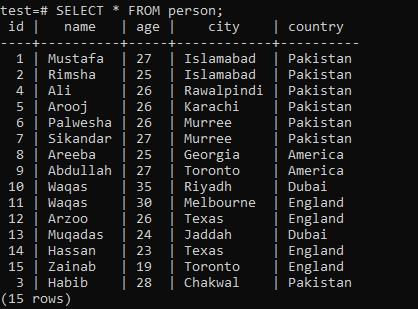
This can be solved by flipping the order of the statements. On the first approach, the problem was that the INSERT query was not updating on conflict, thus the RETURNING row is empty when the row already exists.
#Postgresql insert conflict update#
With this explained, it is confirmed why doing ON CONFLICT UPDATE is not a good choice either. The destruction transaction id ( t_xmax) is 0 because no changes happened to the row.Īs you can probably guess an UPDATE is a DELETE + INSERT under the hoods.The transaction id used for the creation of the row ( t_xmin) is 5920.The destruction transaction id ( t_xmax) is 5920 because the row was DELETED.The transaction id used for the creation of the row ( t_xmin) is 5919.t_ctid indicates that the row is stored on page 0 and block 2.With that explained, lets introduce how an UPDATE works on postgres: The main advantage of using the MVCC model of concurrency control rather than locking is reading never blocks writing and writing never blocks reading. MVCC, minimizes lock contention in order to allow for reasonable performance in multiuser environments. This prevents statements from viewing inconsistent data produced by concurrent transactions performing updates on the same data rows. From the DocumentationĮach SQL statement sees a snapshot of data regardless of the current state of the underlying data. In order to elaborate it is important to take into consideration the MVCC (Multiversion Concurrency Control) nature of postgres. xmax is the destruction transaction id of that row.

xmin is the creation transaction id of that row.ctid is the tuple id composed by (page, item).That usually indicates that the deleting transaction hasn’t committed yet, or that an attempted deletion was rolled back. It is possible for this column to be nonzero in a visible row version. The identity (transaction ID) of the deleting transaction, or zero for an undeleted row version. (A row version is an individual state of a row each update of a row creates a new row version for the same logical row.) The identity (transaction ID) of the inserting transaction for this row version. A primary key should be used to identify logical rows. Therefore ctid is useless as a long-term row identifier. Note that although the ctid can be used to locate the row version very quickly, a row’s ctid will change if it is updated or moved by VACUUM FULL. The physical location of the row version within its table. What is the definition of ctid, xmin and xmax, and why do they keep increasing? Just to have more context on the snippets below, the database model will be the following: Benchmarking is going to be displayed on the next part for the approaches 3, 4 and 5. For obvious reasons these ones are not based on real business.



In this part of the series, different approaches are being listed. If the int representation is created, return it.If the int representation is not created, create it.For x uuid there will always be a unique y int.That is fairly simple, but lets go through some more elaborated preconditions: Internal system does a request to external service sending the int ID.This service will generate the int representation for certain uuid.Internal system does a request to the integer generator.This way the int identifier won’t be leaked to any other part of the system. The suggestion then was to have a service which creates an unique integer for a certain uuid. The problem is that IDs in our domain are not integers but uuid. Recently at the company I am working for, there was a need to communicate with an external service which required us to send some data along with an integer identifier.


 0 kommentar(er)
0 kommentar(er)
